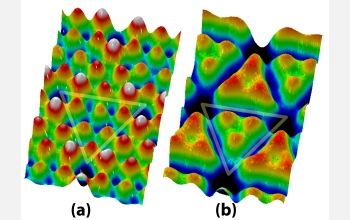Multimedia Gallery
Silicon surface photographed using colored-filtered STM
Two views of a silicon surface, one taken using a conventional scanning tunneling microscope (STM), the other using the newly developed color-filtered STM.
Image A is the type that would be obtained using a conventional STM equipped with a metal tip. What shows up in the image are the atoms (in blue) that have the highest energy electrons associated with them. Image B is a color- or energy-filtered image in which researchers have suppressed the blue atoms and can now observe others that have electronic states at lower energy (in red). This silicon surface is a special case in which the "red" atoms actually lie sort of beneath the blue ones. Via energy filtering, researchers can thus "see through" the blue atoms and selectively image the red ones.
STMs yield atomic-scale landscapes of electronically-conducting surfaces like metal. Researchers at the Colorado School of Mines have demonstrated a powerful new technique for filtering these images. Just as color filters make it easier to discern desired features in a photo, color-filtered STM makes it easier to see desired atoms and chemical bonds on a surface. In this new technique, electrons of different energies are analogous to different colors. Only electrons in desired energy ranges are allowed to jump or "tunnel" to the STM tip to build up images of the atoms or chemical bonds of interest.
Support for the design and construction of the microscope used to obtain these images and for the research activities themselves was provided by a grant from the National Science Foundation's (NSF) Faculty Early Career Development (CAREER) program (DMR 99-85178, "Energy-Filtered Scanning Tunneling Microscopy: A Novel Pathway to Chemical Contrast Imaging on Single Molecules"). NSF also awarded a Small Grant for Exploratory Research (SGER) (DMR 00-81183, "Exploration of Ordering Mechanisms in the Nucleationless Self-Assembly of Quantum Dot Islands") to Percy Zahl, a postdoctoral student who worked on the project. (Year of image: 2002)
Credit: Peter Sutter, Eli Sutter, Percy Zahl and James Bernard, Colorado School of Mines
Images and other media in the National Science Foundation Multimedia Gallery are available for use in print and electronic material by NSF employees, members of the media, university staff, teachers and the general public. All media in the gallery are intended for personal, educational and nonprofit/non-commercial use only.
Images credited to the National Science Foundation, a federal agency, are in the public domain. The images were created by employees of the United States Government as part of their official duties or prepared by contractors as "works for hire" for NSF. You may freely use NSF-credited images and, at your discretion, credit NSF with a "Courtesy: National Science Foundation" notation.
Additional information about general usage can be found in Conditions.
Also Available:
Download the high-resolution JPG version of the image. (1.8 MB)
Use your mouse to right-click (Mac users may need to Ctrl-click) the link above and choose the option that will save the file or target to your computer.



